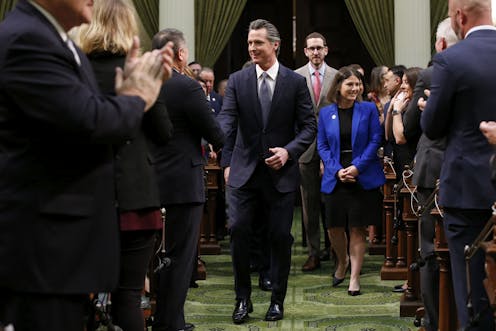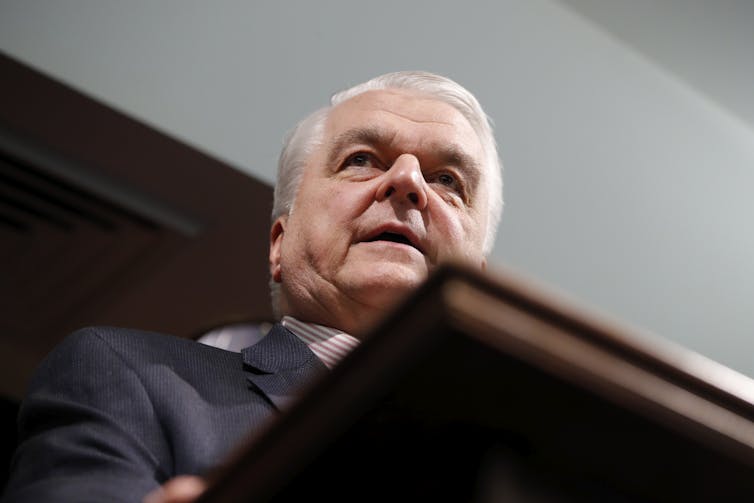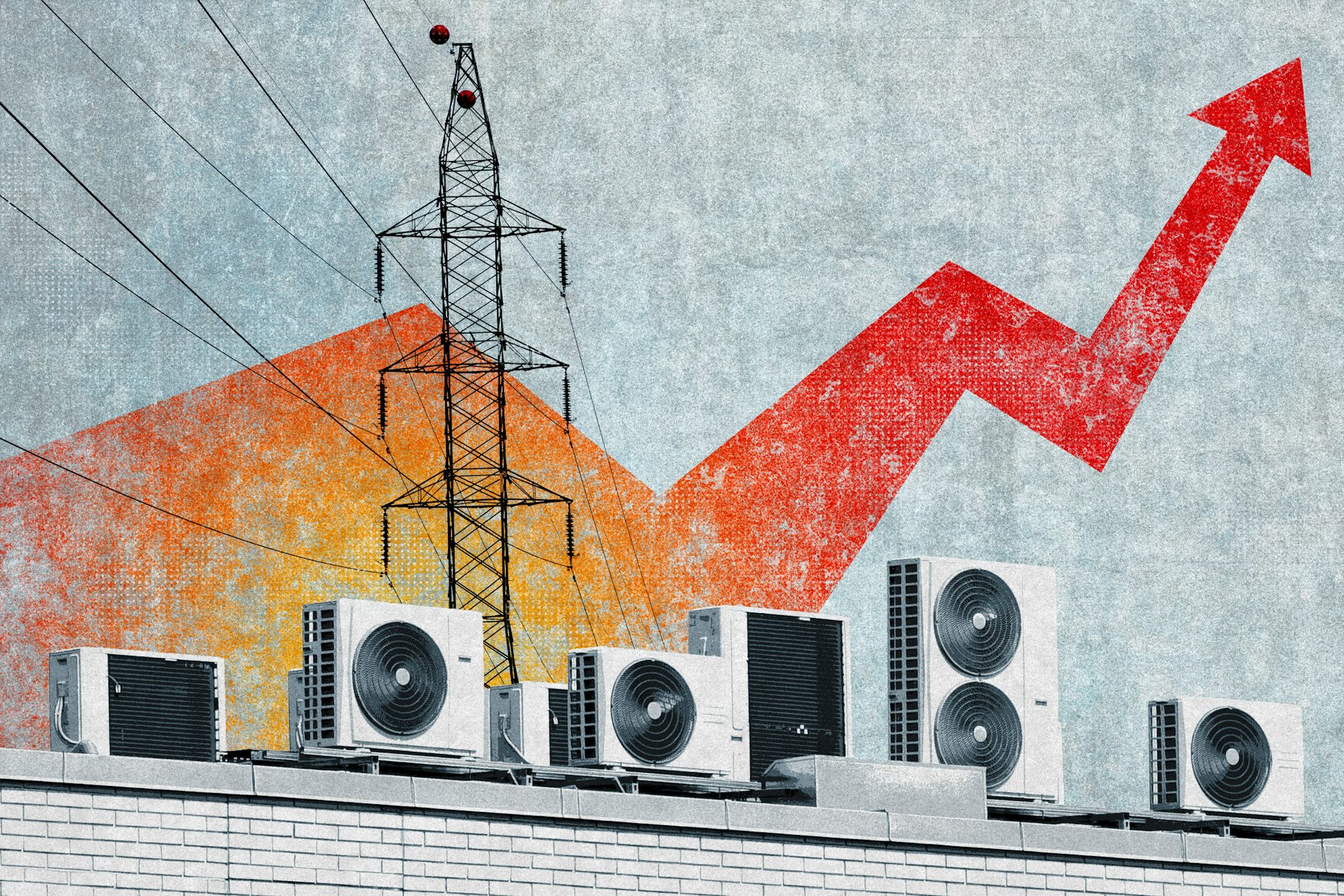Who wants to be a governor now?
As Congress considers further financial help for victims of the coronavirus pandemic, the magnitude of the fiscal crisis that governors and their states will have to face is just starting to emerge.

“Governors Have the Best Political Jobs in America” is the name of one of my lectures in a leadership course I occasionally teach at the University of Virginia.
In that class, I describe how governors have huge appointment powers for their personal staff, agency directors and even boards and commissions.
Governors dominate state legislatures, which are often part-time with few staff. They have substantial say over state budgets, which in 2019 ran from US$6.1 billion for a small state like New Hampshire to $311.3 billion for California.
When former governors Ronald Reagan, Bill Clinton and George W. Bush later became president and had to work with the U.S Congress, they wished they still had the line-item veto powers they had as governors, which allowed them to cut individual items in the budget passed by the legislature.
Today, as governors continue to provide leadership on the coronavirus crisis they are about to confront a second crisis, as their state’s fiscal positions will rapidly deteriorate. In my view, it will be as bad as the Great Recession of 2008 to 2009 and its aftermath.
I might call that lecture now “Governor, why did you want that job anyway?”
The magnitude of the fiscal crisis that governors and their states will have to face is just starting to emerge. And that crisis will affect states’ abilities to do everything from paying teachers to paving roads to providing social services.
Money in, money out
Total state spending in 2019 was about $2.1 trillion. In national summary figures, the largest state program is Medicaid, which is about 28.9% of total spending, substantially above the 19.5% for elementary and secondary education and the 10.1% for higher education. The other major spending is for transportation, which is about 8.1%.
The remaining 33.4% is for a catch-all category of smaller programs like the environment and economic development.
On the revenue side of the equation, which is also about $2.1 trillion, the three major taxes on sales, personal income and corporate income make up 40.8% of the total. Special fees and other taxes represent 28.5%. The federal government, through grants and contracts, contributes 30.7%.
There are five key components in understanding the seriousness of the challenge to states and their governors. They reflect the complex interplay between the federal and state levels of government, commercial activity and a state’s need for money to operate and provide services:
1. Rainy day funds will quickly evaporate
Before the pandemic hit, states collectively had built-up rainy day and other surpluses of $113.2 billion – an all-time high – amounting to 13% of their general fund spending in 2019. Governors thought they were prepared for the next economic downturn.
Unfortunately, these pots of money will likely be empty by the end of June 2020. This is because sales tax revenues began crashing as early as March.
That crash is continuing through the second quarter of the year, as people stop purchasing goods because restaurants, stores and bars are closed and as individuals practice social distancing. Once the revenue from sales taxes dives, states will be forced to turn to – and ultimately deplete – their rainy day funds.
2. Revenues will collapse
The Congressional Budget Office recently released its forecast that included the impact of the coronavirus pandemic. It indicated that economic activity will drop at least 7% in the second quarter and unemployment will exceed 10%.
Others are far more pessimistic. James Bullard, the President of the Federal Reserve Bank of St. Louis, said unemployment could reach 30% in the second quarter.
Masses of people no longer getting paychecks means a big drop in income tax revenue to states.
The three main state taxes on sales, personal and corporate income totaled $718.9 billion in revenues in 2019. During the Great Recession, the Pew Charitable Trusts estimates that states were denied about $283 billion in tax revenue they would normally receive between 2008 and 2013.
How much states will fail to collect in projected tax revenues this time will depend on the depth and length of the downturn. But it clearly will be deeper than the previous downturn.

3. Medicaid spending will explode
As mentioned earlier, Medicaid, a health-care program for low income individuals paid for by both federal and state governments, represents about 28.9% of total state spending.
Thirty-six states have already expanded eligibility of this program up to 140% of poverty (annual income of $17,486 for one person; $36,050 for a family of four) under the Affordable Care Act.
Now, as unemployment skyrockets, many people will have lost their employer-paid health insurance and will qualify for Medicaid if they are under the income threshold. That is an echo of what happened during the Great Recession, when an additional 6 million people – a 14% increase – came on to the Medicaid rolls.
In 2019 states spent $234 billion of their own revenues on medicaid so another 14% increase in the case load could cost over $30 billion per year extra. Far more people will come on the rolls this time, because the unemployment rate will be higher than the peak of 10.5% in the last downturn and the states have substantially expanded eligibility.
4. Governors will cut spending and increase taxes
State governments can’t spend more money than they bring in: 49 of the 50 states have some type of balanced budget requirement in law or in the state’s constitution. Sometimes that simply means that the governor has to submit a balanced budget. Other state mandates require balance to be maintained during the year.
You can already see governors taking action to meet this requirement. Gov. Steve Sisolak of Nevada just asked his state agencies to prepare for up to $687 million in budget cuts to his $14.7 billion budget. Gov. Jay Inslee of Washington is in the process of cutting his state’s $48.5 billion budget by $445 million.
States have not yet begun to raise taxes or fees but, in my view, that will come later.
5. Federal action will be required
The budget cuts and tax and fee increases that governors will be forced to make will weaken aggregate demand and the economy and make the economic downturn deeper and longer.
In the recently enacted Coronavirus Aid, Relief and Economic Security Act the federal government made $150 billion available for state and local governments.
But only the $30 billion in the Education Stabilization Fund created by the act will be to replenish state coffers by offsetting state revenue losses. The rest goes to local governments and to states for additional non-Medicaid health care and hospital costs incurred in the fight against the coronavirus.
States are looking to the federal government to include in its fourth relief package both a major increase in the federal contribution for Medicaid as well as a stabilization fund of $250 billion to assist states in filling the budget gap and buoy the economy.
Because the economy is so much larger now, that would be a contribution similar to the 2009 American Recovery and Reinvestment Act, which provided states with $147 billion in Medicaid and education funds.
The people’s judgment
The economic and public health crises facing states and their governors will have an impact in another realm: politics. In November, 2020 there will be 11 gubernatorial elections, with nine incumbents likely to be running for re-election.
The real test of leadership during the these twin crises will be reflected in the results of those elections.
Raymond Scheppach does not work for, consult, own shares in or receive funding from any company or organisation that would benefit from this article, and has disclosed no relevant affiliations beyond their academic appointment.
Read These Next
Rising electricity prices and an aging grid challenge the nation as data centers demand more power
Energy projects are expensive and take a long time to build. Where to build them is often also a difficult,…
AI-generated political videos are more about memes and money than persuading and deceiving
Don’t discount the threat of AI political videos fooling people, but for now, they’re mostly about…
2026’s abortion battles will be fought more in courthouses and FDA offices than at the voting booth
Judges and federal regulators will make significant decisions over Americans’ reproductive rights.





